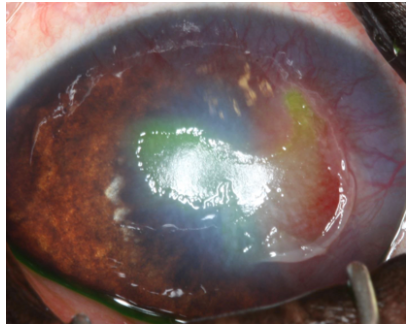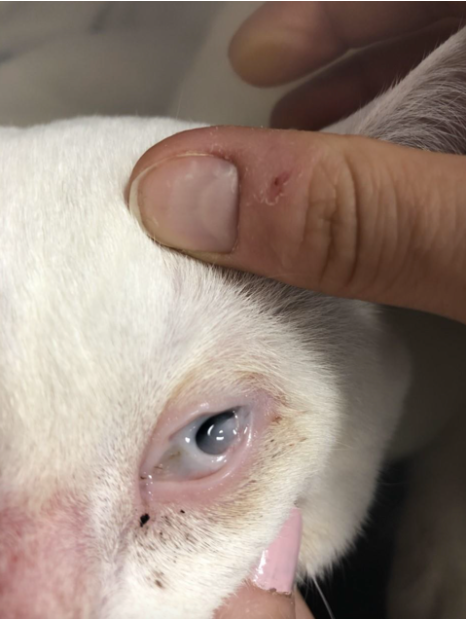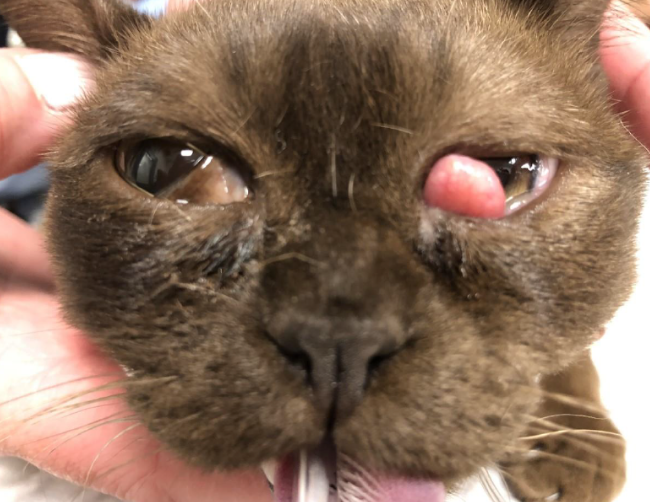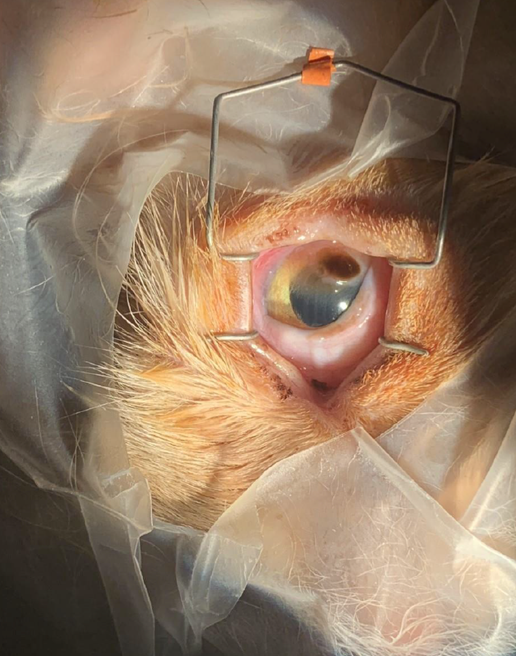Image Quiz: Can you name these ophthalmic conditions? (sponsored by Nationwide)
Test your diagnostic skills by examining the following images and selecting the answer you think fits best.
What is wrong with this middle-aged dog’s eye?
Photo courtesy of Michele Edelmann, VMD, DACVO

A. Pannus
B. Indolent corneal ulcer
C. Descemetocele
D. Proptosis
Answer: B, indolent corneal ulcer
Also known as spontaneous chronic corneal epithelial defects, indolent corneal ulcers are superficial, non-infected corneal epithelial defects that fail to resolve through the normal wound-healing process. There appears to be a predilection for boxers to develop this defect, but any breed can be affected. The average age of affected dogs is 8 to 9 years, but boxers can be affected at any age.
In all cases, a thorough ophthalmic examination should be performed to identify any underlying condition that may impair the normal healing process. These include eyelid abnormalities (e.g. entropion, ectropion, step defect from previous trauma or surgery), foreign body, abnormal hairs (e.g. distichia, trichiasis, ectopic cilia), a deficient tear film or conformational issues (e.g. prominent eye).
The typical appearance is a ring of loose epithelium surrounding a superficial corneal ulcer that appears as a halo of less intense fluorescein staining around a darker center. Therapy typically involves epithelial debridement using a diamond burr, grid keratotomy and/or anterior stromal puncture. A topical antibiotic is required until the corneal ulcer is fluorescein stain negative. If no debridement is performed, these defects can take months to heal.1
________________________________________________________
What is the diagnosis for this young cat’s eye?

A. Symblepharon
B. Foreign body
C. Mature cataract
D. Conjunctivitis
Answer: A, symblepharon
Symblepharon is abnormal adhesion of conjunctival tissue to the cornea or to another conjunctival surface. The condition can be minor (a very thin tissue strand) or extensive and blinding (covering the entire globe). It typically results from severe conjunctivitis, which in cats is caused most commonly by feline herpes virus type 1 (FHV-1). With severe conjunctivitis, there can be large areas of conjunctival and corneal ulceration. The ulcerated areas will form adhesions to one another and to the ulcerated corneal surface. Symblephara are permanent adhesions that occur most commonly with a severe primary infection. They are less likely to form in older cats with recurrent herpesvirus conjunctivitis outbreaks. Surgery to sever the adhesions can be attempted, but many adhesions recur despite aggressive surgical correction.2
________________________________________________________
This 1-year-old pit bull terrier is experiencing no discomfort or systemic signs. What ophthalmic condition would you diagnose?

A. Proptosis
B. Masticatory muscle myositis
C. Extraocular myositis
D. Glaucoma with buphthalmos
Answer: C, extraocular myositis
Extraocular myositis is a focal inflammatory myopathy observed most commonly in young, predominantly large- or giant-breed dogs.3-5 The typical presenting signs are exophthalmos without protrusion of the nictitating membrane, and congestion of the episcleral vessels.3-5 Physical examination often reveals fever, lethargy, weight loss, potential blindness and restricted jaw movement due to swelling of the masseter, temporal and pterygoid muscles.3-5 Advanced imaging (e.g., ultrasonography, computed tomography, magnetic resonance imaging), if pursued, would reveal swollen extraocular muscles.3 Histopathology of the inflamed muscles would reveal CD3+ lymphocytes and macrophages as the predominate cell types.3-5
Most patients with extraocular myositis respond well to a course of immunosuppressive steroids administered over three to four weeks.3 However, detrimental side effects can occur with chronic inflammation. With uncontrolled or chronic inflammation, fibrosis of the extraocular muscles can result in enophthalmos with strabismus.4,5 If enophthalmos is severe, a corrective procedure may be required to reposition the eye.4,5 While its appearance is similar to Graves disease in people, extraocular myositis has no known association with hypothyroidism or hyperthyroidism.3 It should be differentiated from masticatory muscle myositis. Masticatory muscle myositis also results in exophthalmos, but the third eyelid is typically elevated due to swelling of the pterygoid muscle.3-5
________________________________________________________
What is the diagnosis for this young Burmese cat’s eye?

A. Mast cell tumor
B. Orbital fat prolapse
C. Prolapse of the gland of the third eyelid (“cherry eye”)
D. Dermoid
Answer: C, cherry eye
Prolapse of the gland of the third eyelid is less common in cats than in dogs. It has been reported most often in Burmese cats, with cases also reported in Persian and domestic shorthaired cats. Burmese cats are mostly affected as kittens, but the age of onset can be later in domestic shorthairs. Surgical repositioning of the gland is recommended and is equally effective in cats and dogs. If the gland is removed, the cat is predisposed to developing dry eye.2
________________________________________________________
What are the discolored lesion on this cat’s cornea?

A. Iris nevus
B. Feline diffuse iris melanoma
C. Corneal sequestrum
D. Uveal cyst
Answer: C, corneal sequestrum
Corneal sequestration can occur as a primary stromal disease in Persians and Himalayans, or it can be a secondary issue. Secondary causes of corneal sequestrum formation include chronic corneal ulceration, keratitis and irritation from entropion. This cat had a history of entropion following an episode FHV-1 recurrence resulting in conjunctivitis and superficial corneal ulceration.
Corneal sequestra appear as areas of amber, brown or black discoloration. The depth and size of these lesions can vary greatly. A keratectomy (excision of corneal tissue) can be performed to remove the necrotic cornea. A grafting procedure is required if the keratectomy site is deep or to prevent recurrence. If a graft is not performed, a soft contact lens or a temporary tarsorrhaphy should be placed to help decrease the chance of recurrence.6
Help your clients help their pets
As you can see from these cases, pets of all ages can suffer from a host of ocular conditions that require a wide range of diagnostic testing and treatment—many of which must be performed at specialty veterinary hospitals by board-certified veterinary ophthalmologists. That means costs can quickly add up.
Owners who have pet insurance are well positioned to afford any unexpected veterinary care their pet may require throughout its lifetime. Keep in mind that no pet insurance plan covers pre-existing conditions, so getting it when the pet is young is the best way to plan for any health concerns that may arise. This is especially important for breeds that are predisposed to certain diseases (e.g. glaucoma in poodles, cataracts and other ocular conditions in Siberian huskies).
Click here for best practices for broaching the pet insurance conversation with your clients.
Dr. Joslin earned her DVM degree from Oklahoma State University in 2013 and become a diplomate of the American College of Veterinary Ophthalmologists in 2018. She practices at Mount Laurel Animal Hospital in Mount Laurel, New Jersey.

References
1. Ledbetter EC, Gilger BC. Diseases and surgery of the canine cornea and sclera. In: Gelatt KN, Gilger BC, Kern TJ, Eds. Veterinary Ophthalmology, 5th ed. Baltimore, MD: Lippincott Williams & Wilkins; 2013:988-992.
2. Stiles J. Feline ophthalmology. In: Gelatt KN, Gilger BC, Kern TJ, Eds. Veterinary Ophthalmology, 5th ed. Baltimore, MD: Lippincott Williams & Wilkins; 2013:1485.
3. Spiess BM, Pot SA. Diseases and surgery of the canine orbit. In: Gelatt KN, Gilger BC, Kern TJ, Eds. Veterinary Ophthalmology, 5th ed. Baltimore, MD: Lippincott Williams & Wilkins; 2013:808-810.
4. Webb AA, Cullen CL. Neuro-ophthalmology. In: Gelatt KN, Gilger BC, Kern TJ, Eds. Veterinary Ophthalmology, 5th ed. Baltimore, MD: Lippincott Williams & Wilkins; 2013:1862-1863.
5. Cullen CL, Webb AA. Ocular manifestations of systemic disease, Part 1: The dog. In: Gelatt KN, Gilger BC, Kern TJ, Eds. Veterinary Ophthalmology, 5th ed. Baltimore, MD: Lippincott Williams & Wilkins; 2013:1916-1917.
6. Stiles J. Feline ophthalmology. In: Gelatt KN, Gilger BC, Kern TJ, Eds. Veterinary Ophthalmology, 5th ed (ed). Baltimore, MD: Lippincott Williams & Wilkins; 2013:1495-1496.